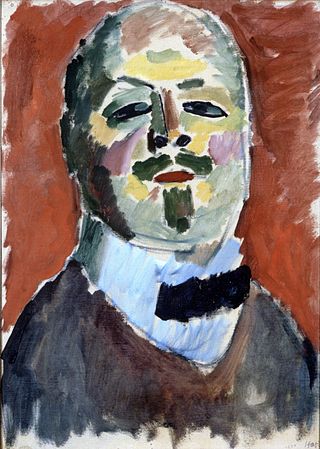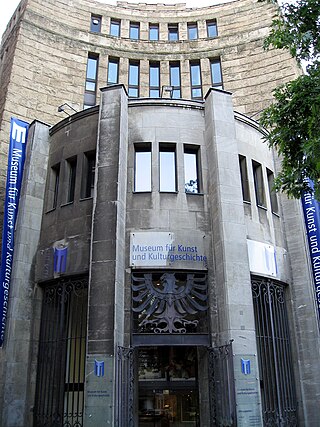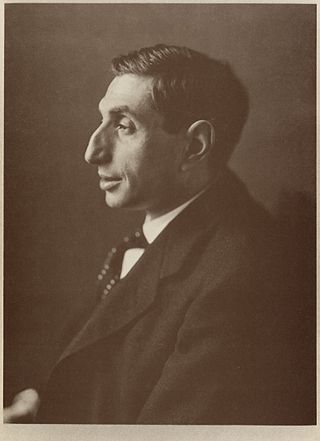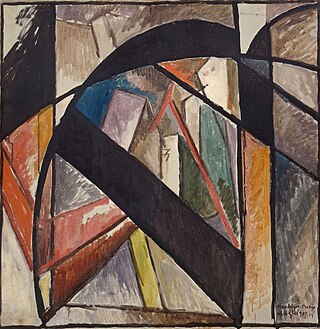History
The museum's original location, from 1947 until 2009, was a building on the Ostwall (a road in central Dortmund following the old city walls), including a small sculpture garden. The previous building on the site had been the Museum für Kunst und Kulturgeschichte (MKK), a municipal art collection, from 1911 until its destruction in World War II; before 1911 it housed the old Westphalia Mining Authority. [1]
A gradual rebuilding, using construction materials from the ruins of the MKK, began in the late 1940s. The first exhibition at the Museum am Ostwall was held in 1949 [1] – making it one of Germany's first post-war museums of 20th-century art – and it continued to be expanded until 1956. The MKK, meanwhile, was provisionally rehomed in Cappenberg Castle until its return to Dortmund in 1983. [1]
In June 2009 the original building closed its doors, and the museum began relocating into the U-Tower, where it reopened under the new, shortened name Museum Ostwall in October 2010. [1] The seven-storey tower, a former Dortmund Union brewery and warehouse, played a key role in the Ruhr Area's rebranding as "Culture Capital of Europe 2010" ( RUHR.2010 – Kulturhauptstadt Europas). [2] The museum reopened with the special exhibition "The Museum as Power Station" (Das Museum als Kraftwerk). [3]
Collection
The collection was initially compiled from works that the Nazis had classified as "degenerate art". The Gröppel Collection, containing around 200 paintings, sculptures and graphics, was acquired in 1957 and is now one of the keystones of the museum. [4]
At the heart of the collection are works by Ernst Ludwig Kirchner, Otto Mueller, Emil Nolde and Karl Schmidt-Rottluff, who founded the movement Die Brücke in Dresden in 1905. The avant-garde Blaue Reiter group, started in 1912, is represented here by the works of Wassily Kandinsky, Franz Marc, August Macke and Alexej von Jawlensky. [4] The collection of Jawlensky is the second-largest in Germany, after that of the Museum Wiesbaden.
The museum also owns 26 graphics by Pablo Picasso from the 1940s and '50s, plus others by Joan Miró, Marc Chagall and Salvador Dalí. The collection includes a single work each by Otto Dix, Lyonel Feininger, Alberto Giacometti, Paul Klee, Oskar Kokoschka and Oskar Schlemmer. Among the still lifes, the highlight is Christian Rohlfs.
In the early 1990s the museum acquired over 1,000 works from the collection of the artist Siegfried Cremer, by artists including Marcel Duchamp, Joseph Beuys, Nam June Paik, Wolf Vostell, Günther Uecker and Jean Tinguely, strengthening the museum's coverage of the Fluxus, ZERO and "informal art" movements.
Activities
1962 saw the opening of a children's painting studio, one of the first such teaching projects in a museum. The "Youth Art Club" (Jugendkunstclub) gives youngsters the chance to visit exhibitions, meet artists, and produce their own works in the museum's studio. During the school holidays it also offers art workshops. Educational projects will continue in the new location. [5]
The exhibition is changed twice a year, in order to present as many works as possible to the public.
The museum's old rooms provided a venue for touring concerts and matinees. The museum also publishes art books and catalogues, partly funded by the non-profit society "Friends of the Museum am Ostwall". [6]

Alexej Georgewitsch von Jawlensky, surname also spelt as Yavlensky, was a Russian expressionist painter active in Germany. He was a key member of the New Munich Artist's Association, Der Blaue Reiter group and later the Die Blaue Vier.

Dortmund is the third-largest city in North Rhine-Westphalia, after Cologne and Düsseldorf, and the ninth-largest city in Germany. With a population of 609,000 inhabitants, it is the largest city of the Ruhr as well as the largest city of Westphalia. It lies on the Emscher and Ruhr rivers in the Rhine-Ruhr Metropolitan Region and is considered the administrative, commercial, and cultural centre of the eastern Ruhr. Dortmund is the second-largest city in the Low German dialect area, after Hamburg.

Adolph Friedrich Reinhardt was an abstract painter active in New York for more than three decades. He was a member of the American Abstract Artists (AAA) and part of the movement centered on the Betty Parsons Gallery that became known as abstract expressionism. He was also a member of The Club, the meeting place for the New York School abstract expressionist artists during the 1940s and 1950s. He wrote and lectured extensively on art and was a major influence on conceptual art, minimal art and monochrome painting. Most famous for his "black" or "ultimate" paintings, he claimed to be painting the "last paintings" that anyone can paint. He believed in a philosophy of art he called Art-as-Art and used his writing and satirical cartoons to advocate for abstract art and against what he described as "the disreputable practices of artists-as-artists".

The Neue Galerie New York is a museum of early twentieth-century German and Austrian art and design located in the William Starr Miller House at 86th Street and Fifth Avenue in New York City. Established in 2001, it is one of the most recent additions to New York City's famed Museum Mile, which runs from 83rd to 105th streets on Fifth Avenue in the Upper East Side of Manhattan.

Otto Müller was a German painter and printmaker of the Die Brücke expressionist movement.

The Herzog Anton Ulrich Museum (HAUM) is an art museum in the German city of Braunschweig, Lower Saxony.

The San Diego Museum of Art is a fine arts museum located at 1450 El Prado in Balboa Park in San Diego, California that houses a broad collection with particular strength in Spanish art. The San Diego Museum of Art opened as The Fine Arts Gallery of San Diego on February 28, 1926, and changed its name to the San Diego Museum of Art in 1978. The official Balboa Park website calls the San Diego Museum of Art "the region's oldest and largest art museum". Nearly half a million people visit the museum each year.

Mark Grotjahn is an American painter best known for abstract work and bold geometric paintings. Grotjahn lives and works in Los Angeles.

Otto Piene was a German-American artist specializing in kinetic and technology-based art, often working collaboratively. He lived and worked in Düsseldorf, Germany; Cambridge, Massachusetts; and Groton, Massachusetts.

The Museum Wiesbaden is a two-branch museum of art and natural history in the Hessian capital of Wiesbaden, Germany. It is one of the three Hessian State museums, in addition to the museums in Kassel and Darmstadt.

The U-Tower or Dortmunder U is a former brewery building in the city of Dortmund, Germany. Since 2010 it has served as a centre for the arts and creativity, housing among other facilities the Museum Ostwall.
Theater Dortmund is a theatrical organization that produces operas, musicals, ballets, plays, and concerts in Dortmund, Germany. It was founded as the Stadttheater Dortmund in 1904. Supported by the German Government, the organization owns and operates several performance spaces.

The Scharf-Gerstenberg Collection is an art museum in Berlin. Its collection of paintings, graphics and sculptures, spanning the period from French Romanticism to Surrealism, is currently housed in former rooms of the Egyptian Museum in Charlottenburg on a ten-year loan. It was founded in 2008, and is part of the National Gallery of Berlin.

The Museum für Kunst und Kulturgeschichte or MKK is a municipal museum in Dortmund, Germany. It is currently located in an Art Deco building which was formerly the Dortmund Savings Bank.
Max Peiffer Watenphul was a German artist. Described as a "lyric poet of painting", he belongs to a "tradition of German painters for whom the Italian landscape represented Arcadia." In addition to Mediterranean scenes, he regularly depicted Salzburg and painted many still lifes of flowers. As well as oil paintings, his extensive body of work encompasses watercolours, drawings, enamel, textiles, graphic art, and photographs.

Alfred Flechtheim was a German Jewish art dealer, art collector, journalist and publisher persecuted by the Nazis.

Hans Dieter Breder was a German-American interdisciplinary artist. He lived and worked in Iowa.
Astrid Klein is a German contemporary artist. Klein works in a variety of mediums including drawing, painting, text, photography and installation and sculpture.

Brooklyn Bridge is a 1915 painting by the French artist, theorist and writer Albert Gleizes. Brooklyn Bridge was exhibited at the Montross Gallery, New York, 1916 along with works by Jean Crotti, Marcel Duchamp and Jean Metzinger.
Rolf Fritz was a German art historian. His research focused on German art from the Middle Ages to the 19th century, especially on the art and cultural history of Westphalia, as well as on various genres of arts and crafts.






















